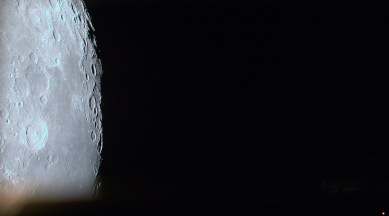Privately-built Japanese moon lander sends beautiful image from lunar orbit
The Hakuto-R lander, built by Japanese private space technology company Ispace, sent back this beautiful image of the Moon from the lunar orbit.

Hakuto-R, the lunar lander built by private Japanese space technology firm Ispace, has sent back another image of the Moon.
Unlike the “crescent Earth” image that it sent back in December last year shortly after launch, this new image was taken from the lunar orbit.
The latest image taken by the mission shows many brightly lit craters on the Moon. It also shows some partially lit craters on the edge of the Moon’s visible “disc” in the image. The rest of the image is dominated by the deep blackness of space.
Ispace’s 2.3 metre-tall lander took a slow, low-energy path to the Moon, where it flew about 1.6 million kilometres from the planet before inserting itself into a lunar orbit. For context, NASA’s Artemis 1 mission reached the Moon about five days after launch.
The Hakuto-R lander is aiming for the Atlas crater in the northeastern section of the Moon’s near side. The crater measures more than 87 kilometres across and is over two kilometres deep.
If the Hakuto-R lander makes a successful landing on the Moon, it will make history as the first privately-built lander to successfully land on our planet’s lone natural satellite. So far, only the United States, Russia, and China have managed a “soft landing” on the Moon.
An Israel-built spacecraft attempted to make the first private-funded lunar landing in 2019. Moments before touching down to complete its ambitious mission, the spacecraft lost all communications with Earth. Shortly after, it was confirmed that the lander crashed into the Moon.
Even India had a similar mishap the same year when the Chandrayaan-2 lander was unable to slow down its velocity fast enough to make a soft landing on the Moon. Earlier this month, ISRO chairman S Somanath said that the primary objective of the follow-up Chandrayaan-3 mission would be to make a precision landing on the Moon.